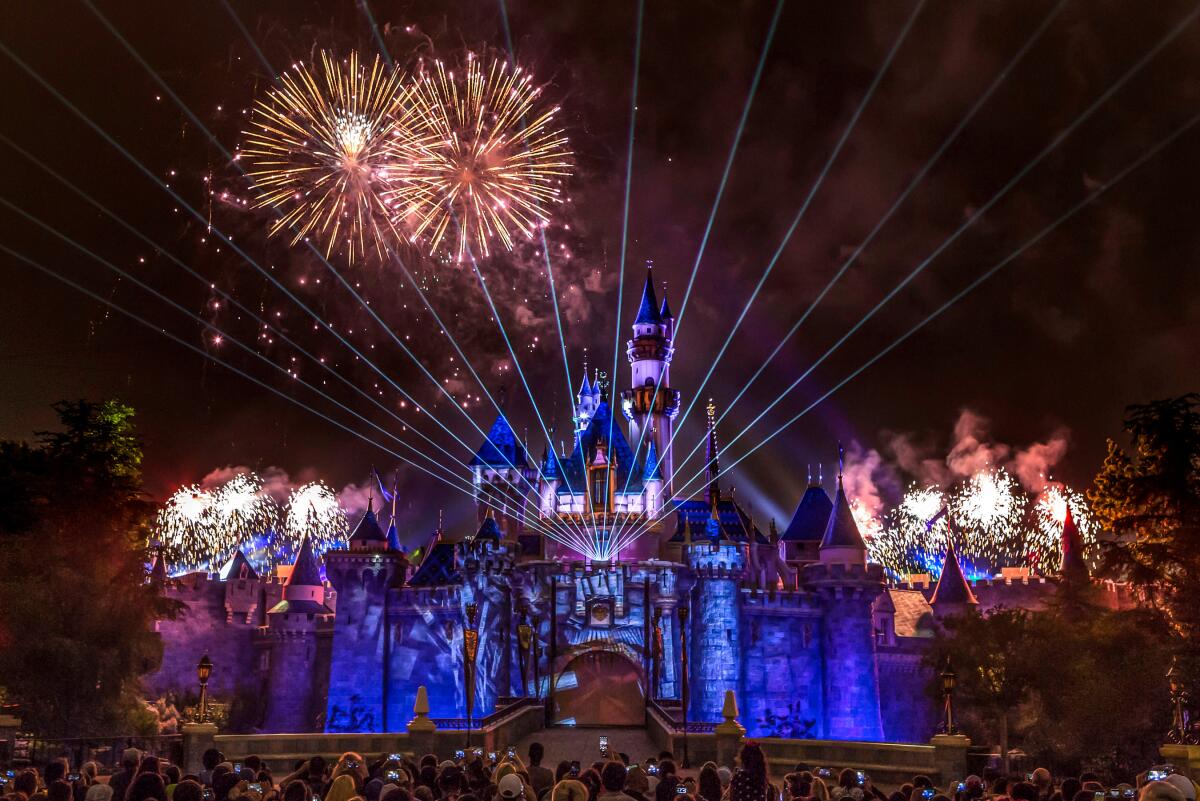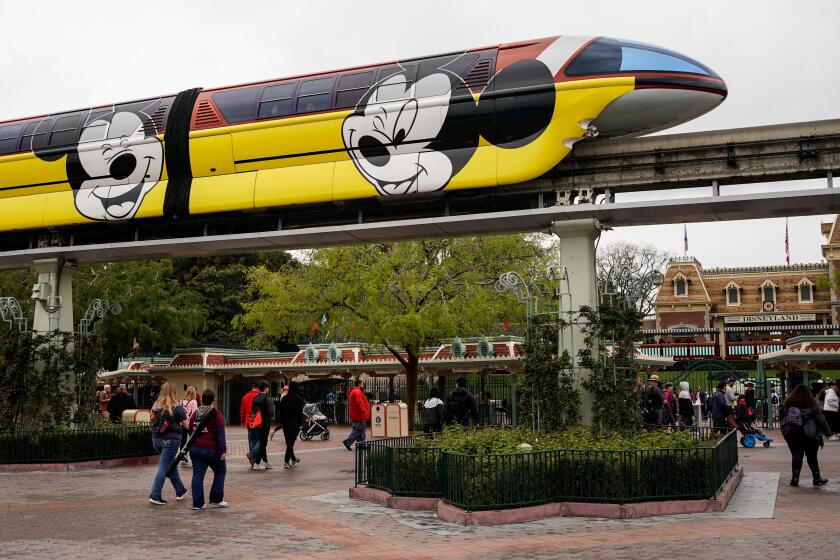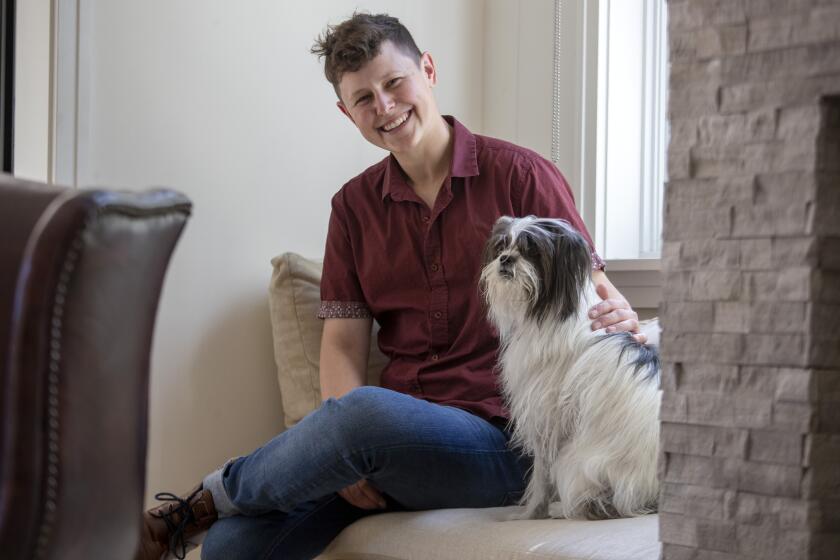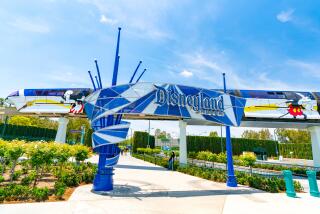Column: Disneyland may be overpriced and crowded. But there’s no escaping it

- Share via
I almost spit out my coffee last week when I read that Disneyland has introduced a new annual pass with a top price of $1,600. (Well, $1,599, but who’s counting?)
I do not pretend to understand the park’s byzantine pass system, which was suspended during the pandemic and reinstated a year ago with a new structure and higher prices before being paused again in May to better control crowds, according to park officials. Last week, Disneyland began selling passes again. But you can’t buy one unless you already have one. Did you follow that?
The new passes, called Magic Keys, are offered in four tiers. The least expensive — at $449 — is available only to residents of Southern California. But passholders should not expect to be able to visit the park during the busiest times of year, especially just before and after Christmas.
“The price hikes — as high as 16% — and the limitations on Christmas visits,” writes my colleague Hugo Martín, “are the latest chapter in the saga of the resort’s annual pass program, which is very popular with hard-core Disneyland fans but has been blamed for increased crowding … especially during peak summer and holiday travel seasons.”
One very disappointed annual pass holder filed a $5-million lawsuit against the company in December, alleging she was deceived by its promise of “no blackout dates” when she purchased her $1,399 annual pass in September. When she tried to make a reservation for November (yes, all visitors now need reservations), she was told nothing was available on her desired dates, she claims in the suit. Yet, according to the disgruntled pass holder, it was possible to purchase single-day tickets for all her chosen days.
“Disney,” says the lawsuit, “appears to be limiting the number of reservations available to Dream Key pass holders on any given day in order to maximize the number of single day and other passes that Disney can sell.” That, it claimed, means that annual passes are “essentially, a ‘second class’ ticket.”
Disneyland annual pass holders will be able to renew starting Thursday.
Disneyland officials say they have been clear about the terms of the passes and will vigorously defend the lawsuit. It would not hurt the company to be more transparent, even though I doubt the lawsuit will put even a pebble-sized dent in the park’s popularity.
Also, good luck trying to figure out how much single-day tickets cost. There are apparently six different tiers, with different prices. All I can tell you is the single-day ticket I bought for my 12-year-old niece in June cost $154. How do working families afford such stratospheric prices?
Many years ago, a Times consumer columnist incurred the wrath of Disneyland, Knott’s Berry Farm and Universal Studios when she suggested that families simply stay away in the summer. “If more people did it,” she wrote, “it would sure thin out the crowds.” I thought she had a point, but the amusement parks were not amused and apparently made their unhappiness known to our then-publisher.
Quite simply, for more than half a century, the Disney universe, well, multiverse, has become inextricably entwined with the lives of American children. (Adults, too. Just Google “Disney weddings.” My stepson told me he once saw a newly married couple stepping out of their horse-drawn glass carriage at the end of their ride. “Is that all?” said the disappointed bride.)
When I was a kid, we gathered in front of the television in the living room at the end of every weekend for “Walt Disney’s Wonderful World of Color.” It was always such a great way to conquer the Sunday night blues. Uncle Walt himself would introduce each episode. It was wholesome family entertainment, yes, and a blatantly seductive ad for Disneyland, the ground-breaking theme park that had opened in Anaheim in 1955.
Fifty years ago, a trip to Disneyland was a huge moment in a family’s life, especially a family like ours with four kids. It was a rare treat, something to save for, something to savor.
I probably visited Disneyland only three or four times in my first 30 years, including on my high school’s “grad night.” Those were the days when young men with long hair would have to tuck their locks under a hat or face expulsion, and young women could wear pants but only as part of pantsuits.
The Disney dress code has relaxed considerably since then, although relatively recently some TikTok influencers claimed they purposely wore skimpy tops to the park to get free shirts, and another raised a fuss after being told she had to change out of her poufy, floor-length princess gown. (It confuses little kids on the hunt for real Disney princesses, say park officials, and could also get tangled on rides.)
Once I grew up, Disneyland helped me discover how much I loathe crowds. Sure, I enjoy a high-speed flume ride as much as the next person, but I have zero interest in waiting in line for more than an hour to be tossed around Matterhorn Mountain, to watch a ghost appear on my shoulder in the Haunted Mansion, or gape at lascivious pirates of the Caribbean who used to auction wenches before Disney caught up with the times.
My family members are Disneyland fanatics who go as often as they can afford to. But these days when they make plans for a day at the park, I bow out.
Still, I avidly follow all news Disney.
Charlee Corra and their parents Roy P. and Sheri Disney gave the Human Rights Campaign half a million dollars.
Especially when someone like Florida Republican Gov. Ron DeSantis decides to bolster his bigot bona fides by punishing the company for opposing his “Don’t Say Gay” law.
Or when the company finds itself in an uncomfortable spotlight for the influence it wields over the city of Anaheim as part of a “cabal,” as the city’s former Chamber of Commerce president described it in a call intercepted by the FBI, that operates to what some locals say is the detriment of the citizenry.
The Walt Disney Co. has occasionally shown itself to be thin-skinned, such as when it banned Times entertainment journalists from screenings and other events after the paper ran a two-part series in 2017 about its ties to Anaheim city government.
However you feel about the company, or its theme parks, streaming channels and merchandise, it is an undeniable cultural force that has infiltrated our lives.
Years ago, when my daughter was a toddler, we drove past a Disney building in Burbank, with Walt’s distinctive loopy signature on display. She had been to Disneyland once and was already an avid watcher of the Disney Channel and consumer of Disney-brand toys.
“Wook!” she said, pointing. “Disney!” It was the first word she ever read out loud.
More to Read
A cure for the common opinion
Get thought-provoking perspectives with our weekly newsletter.
You may occasionally receive promotional content from the Los Angeles Times.














